Rescuing passengers from a stalled elevator can be challenging. Safety for those on scene is always the highest priority. In any elevator rescue, have the building representative call for an elevator technician as soon as possible.
- What’s in Your Elevator Response Bag?
- Training Minutes: Spotting the Elevator
- High-Rise Fires and Elevator Functions
- Stalled Elevator Operations
There are many hazards present. Secure power to prevent elevator car movement. Post a watch at the elevator shaft doors that you open to reduce the chance of falls. Be aware that in the adjacent shaft, elevator cars may still be moving. After you have secured these hazards, the rescue may be as simple as opening the elevator doors to remove the trapped people. If the car is between floors, then you may need to remove victims from the floor above the stalled elevator. If the floor directly above has no elevator doors, this is called a blind shaft. This is a more challenging type of rescue that requires using a rope system.
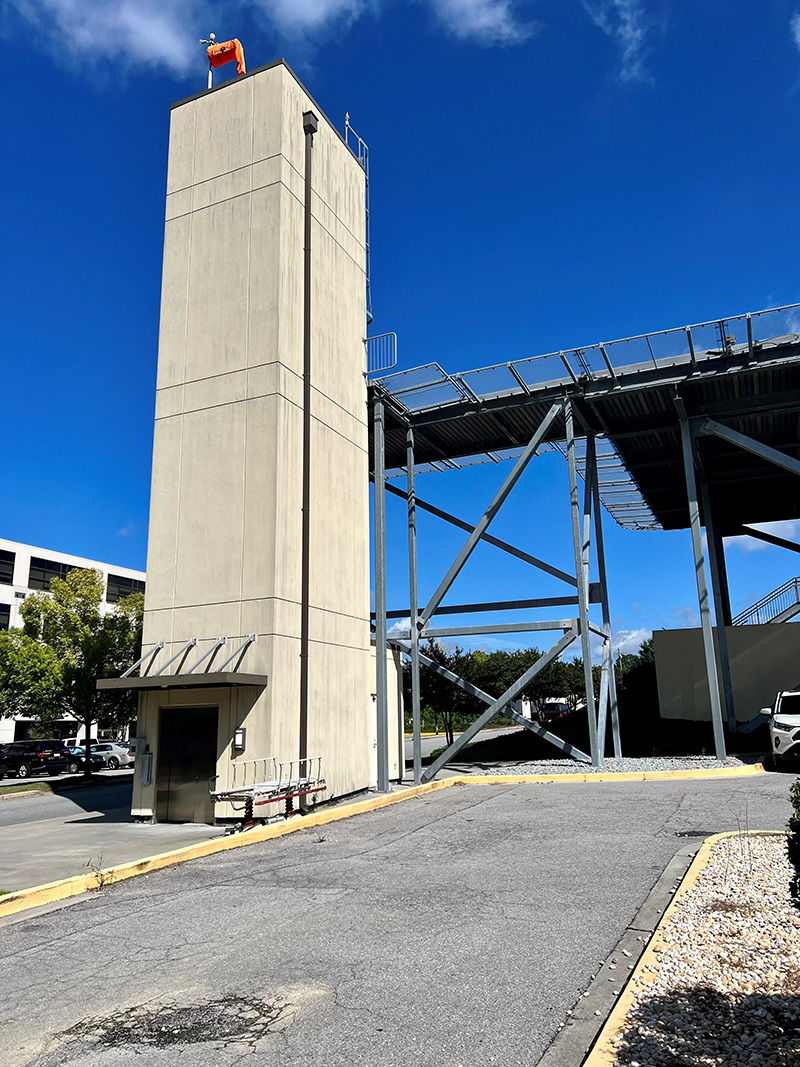
(1) This blind elevator shaft at a hospital helicopter landing pad has an opening on the ground level and at the landing pad midway up, from which it would be a 20-foot drop to the top of the elevator car. (Photos by author unless otherwise noted.)

(2) The rescuer on the top of the elevator car is assessing access to the interior. Note the limited space. [Photo courtesy of Chief Stephen Gollan, Fort Lauderdale (FL) Fire Rescue.]
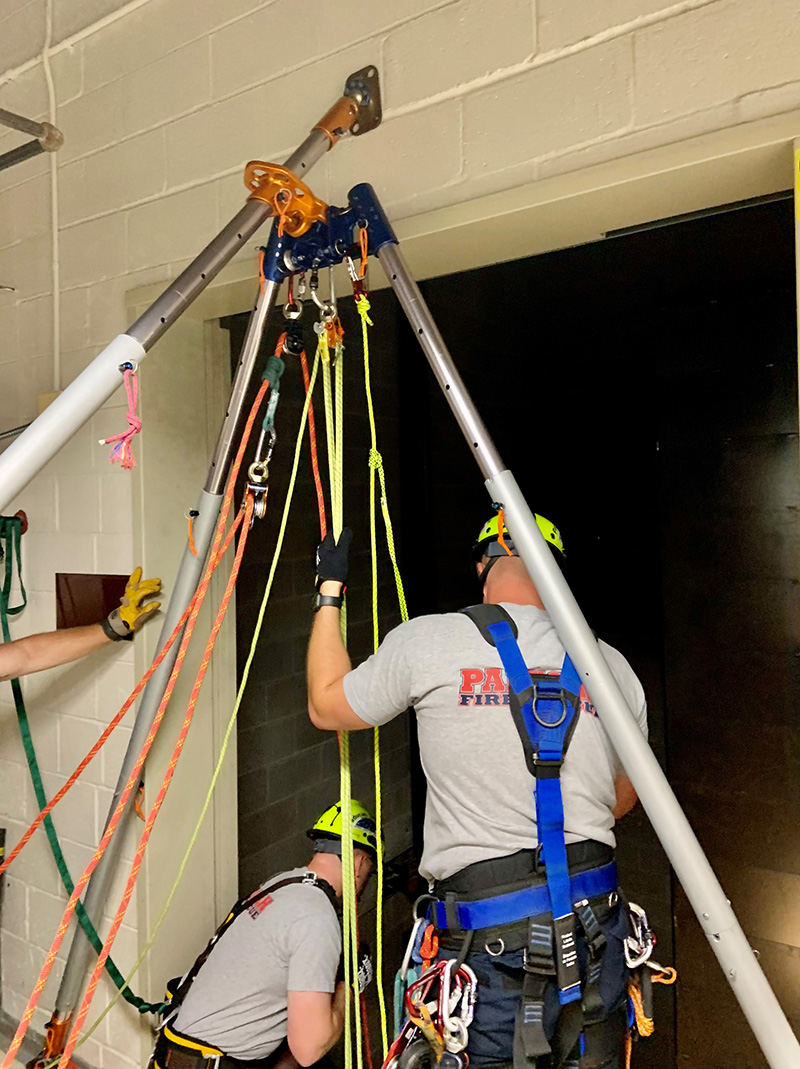
(3) Paducah (KY) firefighters wear and use fall arrests near the open shaft.
Tools needed. You may need a number of tools on your apparatus at an elevator rescue. Lighting may be limited, so always bring flashlights. Other tools include the following:
- Lockout/tagout kits for elevator power.
- Elevator drop keys to open shaft doors.
- Several door chocks to keep the doors open.
- Attic ladder.
- Forcible entry tools.
- Pike pole to access the restrictor latch from the floor above.
- Fall protection for rescuers.
- Rope rescue gear.
Making the scene safe. The elevator power must be controlled before making entry. This is important to ensure the safety of our crews and the citizens we are rescuing. Securing power will depend on the elevator type (hydraulic, traction, or machine room-less) involved. After you have had the power shut off, use a lockout/tagout kit to prevent the power from being turned on. If possible, keep the power for the light and fan on; this is often controlled by a separate 110-volt power switch. Always follow your standard operating procedures for securing power to an elevator.
A piston-operated hydraulic elevator is common for buildings up to 50 feet high. The elevator machine room is usually located on the first floor next to the elevator. Shut off the power to the elevator.
In taller buildings, a traction elevator uses cables to hoist the elevator and the machine room is located above the cables, commonly on the building’s roof. Find the power for your elevator and secure it.
In a machine room-less elevator, the elevator equipment will usually be located in the elevator pit. A separate elevator shutoff might be anywhere in the structure. This can be the most challenging elevator type for finding the main power switch.
If there is an elevator adjacent to your rescue elevator, remove all occupants from that elevator and secure the power to that car. This will prevent injury from a moving car next to your rescue scene.
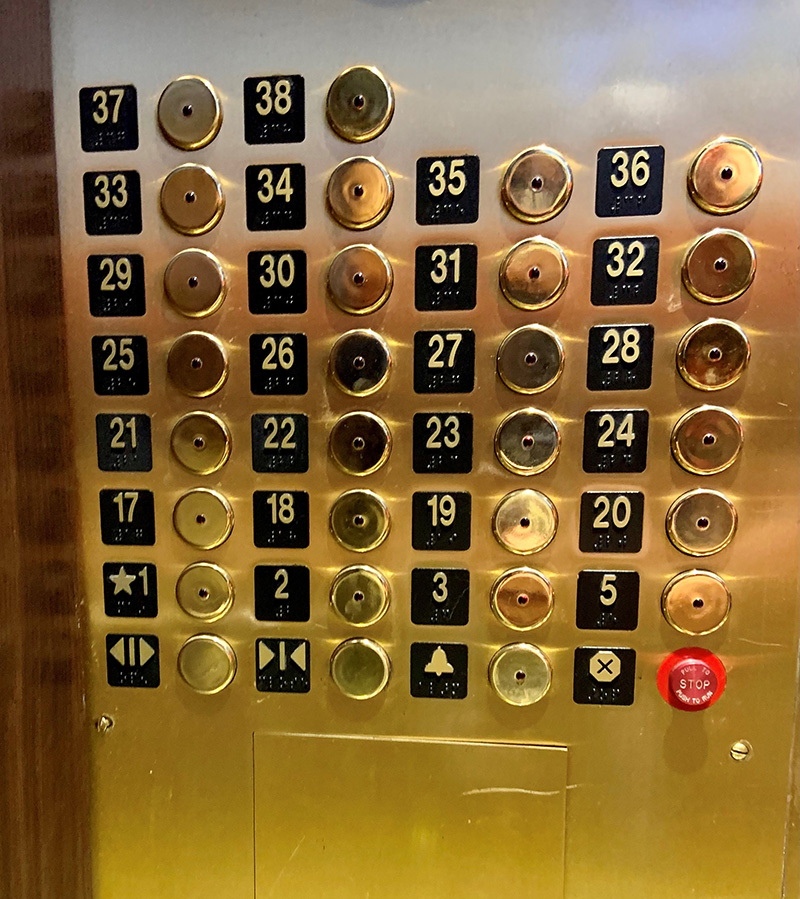
(4) A panel for an elevator with a blind shaft, which has no door openings between floors 5 and 17.

(5) A drop key used to open elevator doors.
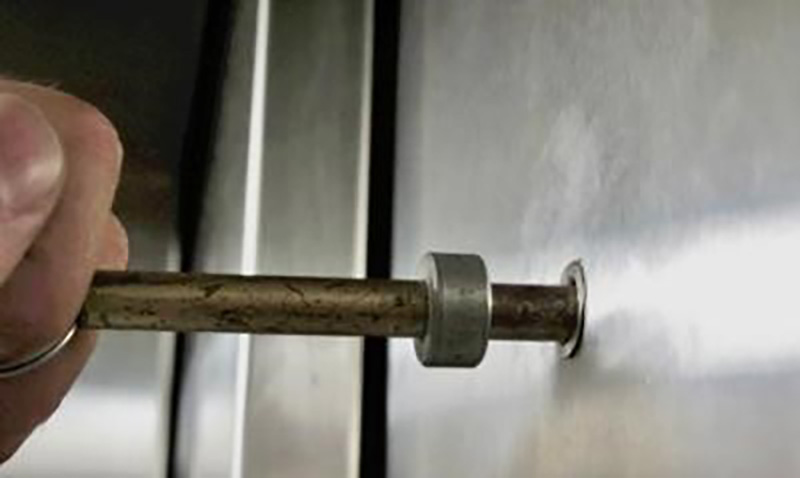
(6) An elevator drop key is inserted into the opening of the door. (Photo by Rolando Busto Jr.)

(7) An interior view of the drop key contacting the internal release mechanism.
Blind shaft. A blind elevator shaft rescue is one in which the top of the elevator car is more than 10 feet below the door opening above the elevator. If it were 10 feet or less from the opening above, you could use an attic ladder to access the elevator car. It is often too difficult to bring a ladder longer than 10 feet through a stairwell to the floor of entry. If the car is positioned more than 10 feet from the opening, then you must use a rope rescue system to retrieve passengers from it. You can do this typically by accessing through the roof of the elevator cab. Call for a technical rescue team early in the operation. Never attempt a rescue for which you have not trained.
Blind shafts are typically found in the following situations:
- An express elevator from the lobby to a penthouse or to the top floor of a hotel or commercial occupancy. This usually takes patrons to a top-floor restaurant or observation deck.
- An elevator bank that serves the lower floors next to an elevator bank that serves the upper floors. For example, from the lobby, one bank serves floors 2 to 25 and the other bank serves floors 26-50.
- A tall first-floor ceiling where the elevator goes from floor 1 to 2. I have seen these blind shafts in convention centers, boat dealership showrooms, cruise ship disembarkment buildings, casinos, helicopter landing pads, and hotel lobbies with extremely high ceilings.
Elevators have two sets of doors. The door or a set that opens on each floor is called the shaft door. The elevator car’s doors are the hoistway or car doors. The elevator shaft door is opened with an elevator key. Most shaft doors will open with a drop key, which has a knuckle on it that allows part of it to drop 90° after it is inserted into the door keyhole. Once inserted, turn the key 180° to the left or right to contact the release arm. Put gentle pressure on the release arm and the door will open it. Other drop keys may have a half-moon shape. This type of key is inserted, then lifted upward.
The elevator car door has a gate restrictor that prevents occupants from opening the door. Rescue crews can locate this after opening the shaft doors. Elevator car doors may open only a few inches because of the restrictor. When you find the restrictor at the top of the door, lift upward to release the doors.
Rescue Rigging
Rope rescue teams will operate in one of two methods: They will rig on a floor above the entry-point floor or they will construct all rigging and enter from the same floor. If the rescuers choose to run their rigging on a floor above the entry point for rescuers, they eliminate the need for an artificial high anchor device. The upper floor itself is the high anchor. The disadvantages of using the floor above as the high anchor are the following:
- It increases the fall potential since there are two open elevator doors, one on the entry floor and one on the high-point floor, vs. a single door.
- Communication between floors can be difficult. Rescue teams must post one firefighter on the floor above with communication to rescuers at the entry floor. The upper-level firefighter has no line of sight of what is being accomplished with rigging or operations.
- Safety checks are needed on two floor levels vs. one.
Rigging and entering on one floor requires an artificial high anchor device. These devices are similar to a tripod, but they are more adjustable. During assembly, two legs will be placed against the wall with the elevator shaft door. The third leg, known as the easel leg, is perpendicular to the elevator door. Set this leg out as long as possible to allow the longest area for hauling. For additional stabilization, it is recommended that the easel leg extend through the head and contact the wall directly above the elevator door. Place a flat foot on the upper end of the easel leg to limit damage to the building wall. Some rescue teams will use a 12- × 12-inch wood gusset plate on this foot to disperse the load across a wider area.
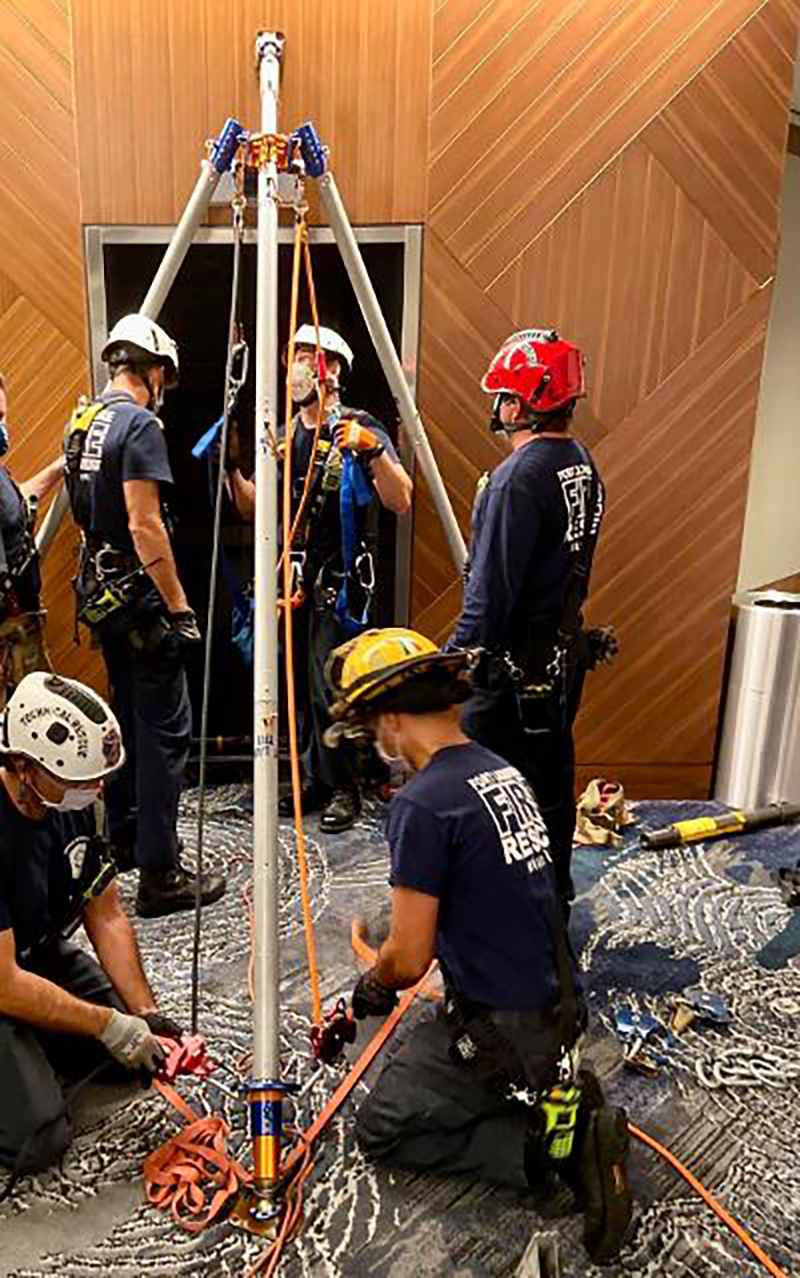
(8) In October 2020, Fort Lauderdale firefighters set up rigging on the entry floor to rescue a person trapped inside a blind elevator shaft.
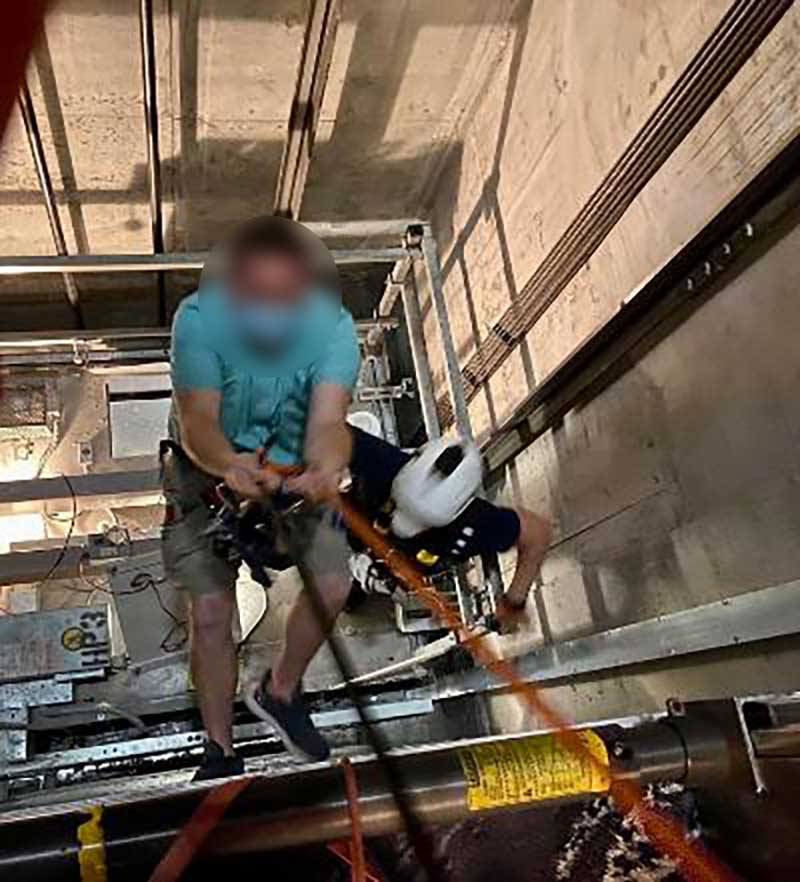
(9) Inside the elevator shaft, an adjustable pneumatic shore with “L” ends attached acts as edge protection for the rope and as a technique to maintain continuous contact between the wall and the high anchor device. [Photos 8-9 courtesy of Chief Stephen Gollan, Fort Lauderdale (FL) Fire Rescue.]
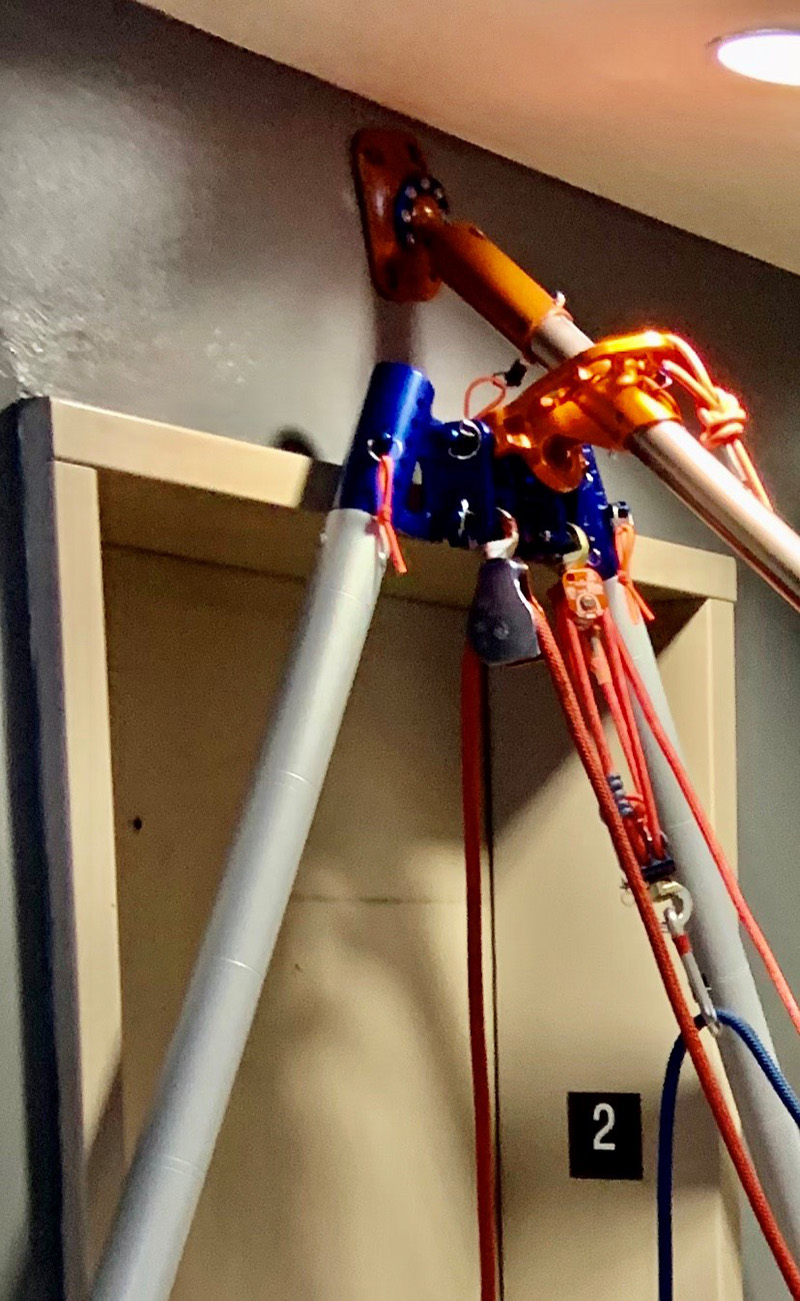
(10) The head of the high anchor should be above the door opening to prevent it from tipping into the shaft. Some teams prefer to place a 12- × 12-inch wood plate between the upper easel leg and the wall to limit damage.
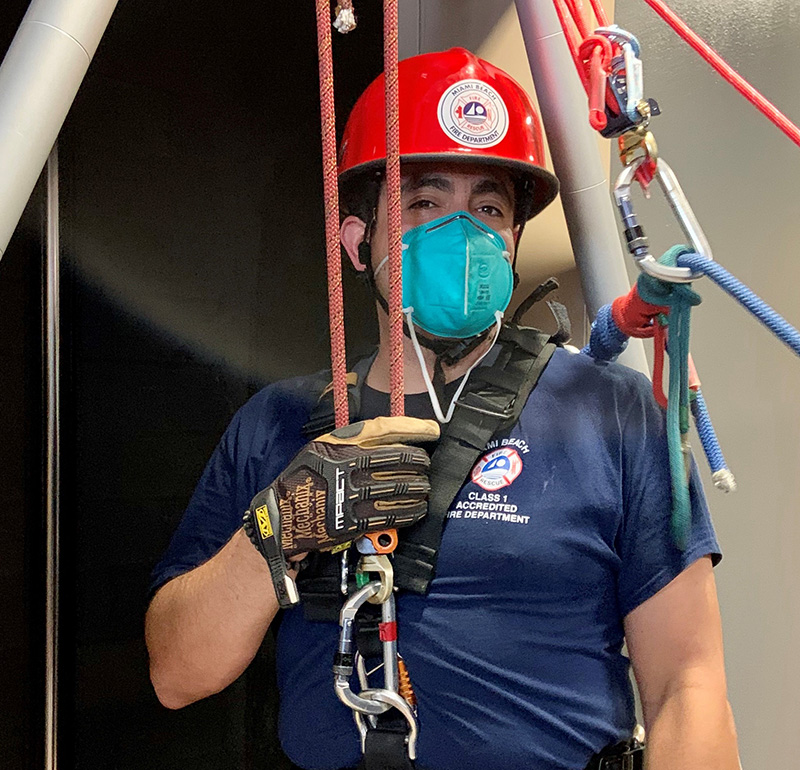
(11) The belay rope (the blue rope secured to the rescuer’s back) runs through a carabiner on the end of a mini set of fours. This will keep the belay above the rescuer as he is standing at the entry point, and it can be lowered to the floor during descent. Lowering the belay rope minimizes the fall factor if the tripod were to tip over during the lower or haul operation.

(12) The rescuer is blocking the opening to prevent the patient from falling into the shaft.
If you have an anchor directly across from the elevator door, use it. It is uncommon to have an anchor in the upper elevator lobby. The easel leg of the artificial high anchor may be used as your rigging anchor. Maximize the rigging area in the hallway to minimize the number of resets during the haul. Your lowering device will be attached as close as possible to the foot end of the easel leg. You may also need to attach your belay to the easel leg if you cannot find another suitable anchor. Bring the artificial high anchor tight against the wall. Some teams will place a pneumatic shore with “L” foot ends just inside the elevator shaft door. This will give an anchor to help snug the artificial high anchor device against the wall. Having the device snug to the wall reduces rocking as the victim and rescuer are hauled out of the shaft. A second advantage of the pneumatic shore is it provides smooth edge protection for your ropes.
Rescue Challenges
The top of the elevator car is a difficult place to package a patient. There is limited space. Hazards include moving adjacent elevator cars, electrical components, and other concerns. The hatch into the elevator car is narrow or nonexistent. Once rescuers bring the trapped person to the elevator car roof, the easier rescue technique is to haul the victim without the added weight of a rescuer. If the rescuer must accompany the patient, the transition from the shaft to the landing can be tricky. Remove the patient first, then the rescuer. This way the rescuer can assist with blocking the opening in case the patient stumbles in the wrong direction. After the rescue is complete, never place the elevator back in service. A trained elevator technician must do this. Ask the building manager to request a technician as soon as possible.
. . .
Elevator shaft rescues are not uncommon. Preplan your jurisdiction to understand what types of elevators you may encounter. Know where the elevator power shut off is located. No rescue should be attempted without securing movement of the elevator car. Elevator rescues require technical rope skills when they occur in a blind shaft. Call for a technical rescue team early into the incident. Never attempt a rope rescue if you have not trained on this type of scenario.
JEREMY RIFFLARD is a technical rescue instructor at the South Carolina Fire Academy, L2 Defense and the program manager for Technical Rescue Training. Previously, he served as a battalion chief with the West Columbia (SC) Fire Department. Rifflard presented on swing-stage scaffold rescue at FDIC International 2019. He is the lead instructor for the Scaffold Rescue Program and the Structural Collapse Program at the Coral Springs (FL) Regional Institute of Public Safety.

